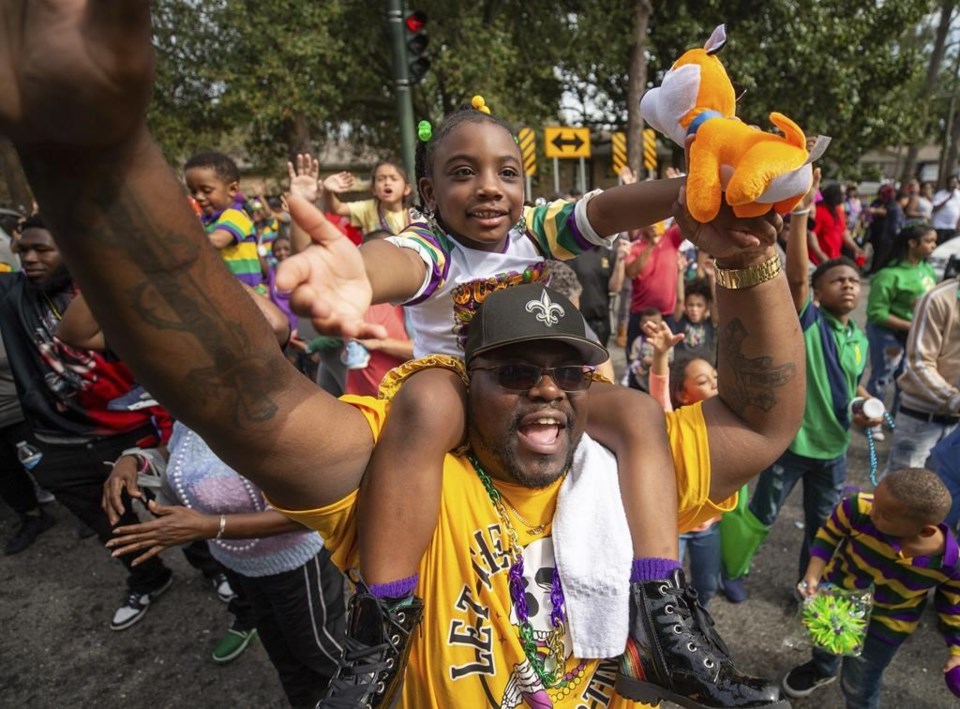NEW ORLEANS (AP) — New Orleans bade a typically joyous goodbye to Carnival season Tuesday with Mardi Gras parades, street parties and what amounted to a massive outdoor costume festival around the bars and restaurants in the French Quarter.
Revelers in capes, wigs, spandex and feathers danced in front of St. Louis Cathedral at Jackson Square while Latin music blared. Not far away, tourists and locals roamed Bourbon and Royal streets with costumes that varied from the scanty and suggestive to the fanciful.
There were pirates, mimes and a family of giant bananas. A group of black-robed, white-wigged judges downed drinks outside a bar wile, nearby, a fluorescent green gorilla pushed a shopping cart through an intersection and a half-dozen blonde-wigged, fur-coat-wearing “Kens” from the “Barbie” movie posed for pictures with passersby.
Initially light crowds grew markedly as the overcast, cold morning gave way to sunshine and milder temperatures.
Outside the narrow streets of the quarter, two tradition-rich parades rolled on a route that took them through the city's Uptown neighborhood and onto Canal Street in the business district. First came the Zulu Social Aid and Pleasure Club, with marchers and riders in African-inspired garb handing out the century-old club's signature gift — hand-decorated coconuts. Later, Rex, King of Carnival rolled down St. Charles, stopping for a ceremonial toast at a historic downtown building with Mayor LaToya Cantrell.
Mardi Gras — or Fat Tuesday — is a secular holiday but it's tied to Christian and Roman Catholic traditions. It always falls the day before Ash Wednesday and is seen as a final day of feasting and revelry before the solemnity of Lent.
“I was raised Catholic, so tomorrow’s for repenting but today is for partying," Bethany Kraft, a regular visitor from Mobile, Alabama, said as she waited for parades with her husband Alex. She wore a white dress and a headpiece shaped like a crescent moon; he, a Fred Flintstone costume.
Monday night featured the parade of the Krewe of Orpheus, co-founded by home-grown musician and actor Harry Connick Jr. In addition to elaborate floats and marching bands, participants included Connick himself, actor Neil Patrick Harris and Harris’ husband, David Burtka.
New Orleans has the nation’s largest and best known Carnival celebration. It's replete with traditions beloved by locals. But it's also a vital boost to the city’s tourist-driven economy — always evident in the French Quarter.
“No strangers down here,” visitor Renitta Haynes of Chattanooga, Tennessee, said as she watched costumed revelers on Bourbon Street over the weekend. “Everybody is very friendly and approachable. I love that.”
She and her friend Tiffany Collins wore giant purple, green and gold bead necklaces as they sipped drinks.
The annual pre-Lenten festivities aren't limited to New Orleans. Similar celebrations are held in Louisiana and along the Gulf Coast. Mobile, Alabama, where six parades were scheduled Tuesday, lays claim to the nation's oldest Mardi Gras celebration. And other lavish Carnival celebrations in Brazil and Europe are world renowned.
Monday's activities in New Orleans also included an afternoon “Lundi Gras," or Fat Monday celebration on the Mississippi Riverfront, including live music. Part of the event was the annual ceremonial meeting of the man tapped to be this year’s King of Carnival — chosen by the Rex Organization, a predominantly white group with roots in the 19th century — and the man elected king Zulu, founded by Black laborers in the early 1900s. The meeting is a custom that began in 1999 in what was seen as a symbol of slowly eroding social and racial barriers.
Kevin Mcgill, The Associated Press




